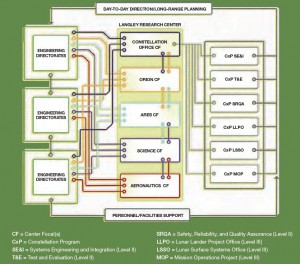
By Keith L. Woodman
If you asked the typical project manager how much authority he wants, he would likely respond by saying the more, the better. In NASA’s increasingly complex project environment, however, project managers often find themselves facing situations where they have less authority than they would expect. This is the nature of what is called a weak-matrix project. But “weak” is poor choice of words because only strong leaders will succeed in this challenging project environment.
The Weak-Matrix Project Environment
As our Agency’s projects increase in size, complexity, and distribution, a secondary project manager is often needed. This secondary project manager represents both a project’s interests at a geographically distributed support organization and the organization’s interests within the project. This position can go by many names, including weak-matrix project manager, distributed project manager, or, in the case of the Constellation program, center focal.
In the weak-matrix environment, the center focal communicates the project’s requirements to his or her center’s functional engineering units, which may contain design, development, testing, and fabrication capabilities. After needs and capabilities are identified, the center focal leads negotiations between the center and the project leaders to develop resource and task agreements. Once those are in place, the center focal is responsible for managing the budget allocated by the project and for ensuring the timely delivery, completion, and quality of the products developed at the center.
The center focal’s role is different from the traditional project manager’s. Unless requested to do so by the project manager, the center focal does not plan or direct the day-to-day or long-range tasks for the personnel who support the project. The project manager or her technical subordinates do that; the center focal’s responsibility becomes coordination, integration, and oversight of these tasks. In this respect, the center focal has much less authority than the traditional project manager.
The Langley Research Center Constellation Projects Office exists in a weak-matrix environment with some complicating factors not accounted for in the generic model. The first complicating factor is that the office represents six Constellation program (CxP) projects: three Level II offices, the Lunar Lander and Lunar Surface Systems Project Offices, and the Mission Operations Project Office. Each of these projects has its own requirements and ways of conducting business. For example, some projects require formal internal task agreements with Langley while other projects will insist that there is no need for formal agreements. It is up to the center focal to adapt to these varying cultures and make the situation work.
Another challenge involves workforce availability and established commitments. Several other projects draw on Langley’s resources. For Constellation at Langley, there are separate Orion and Ares project offices, as well as project offices representing the Agency’s science and aeronautics programs. Attempting to balance priorities across the exploration, science, and aeronautics programs requires constant and complex negotiations between the center focals, the projects they represent, and Langley’s engineering directorates. It also requires continually balancing the civil servant and contractor workforce. Successful negotiations require the center focal to meet constantly with the center’s line management and other project focals to communicate issues and needs and to establish priorities.
While the weak-matrix project might sound like a situational nightmare to some, it can be a very rewarding activity to lead and offers the center focal some unique opportunities that other project management positions do not. Successfully leading a weak-matrix project calls for situational awareness, negotiation skills, technical assignments, and influence.
Situational Awareness
Langley, like other centers, offers a wide range of engineering disciplines and facilities. Because it is so large and diversified, few people can claim to have complete knowledge of the center’s capabilities, but center focals need to know a lot about them to do their jobs well. One effective way to develop organizational knowledge is setting up and conducting tours. Conducting tours for visiting project leaders not only acts as a reinforcement of the center focal’s knowledge, it may also reveal new or unknown center capabilities.
To develop an intimate understanding of a project’s requirements, culture, and way of conducting business, the center focal should take advantage of opportunities to meet the project manager face to face. When travel is not possible, center focals should “virtually” attend as many project meetings as possible. As situational awareness of the project and the organization grow, the center focal becomes an information conduit, keeping his or her organization informed of the project’s needs and ensuring the project understands the organization’s abilities and commitments.
Often, center focals compete against other projects for their organization’s resources. Understanding the nature of these other commitments and the priority level assigned to them will aid the center focal’s negotiation skills.
Negotiation Skills
Negotiating in the weak-matrix project environment is like walking a multidimensional tightrope. The center focal must continuously balance the project’s changing needs with the center’s capabilities while maintaining an awareness of the priority level of all activities. In this complex, multiparty environment, negotiating “win-win” solutions is rare. Typically, the optimal solution is satisficing—satisfying as many of the interested parties as much as practically possible. When dealing with many interests—the project’s, the center’s, the employees’—the center focal must constantly ask, “What solution will bring a balance between the Agency’s values of safety, teamwork, integrity, and mission success?”
The health and welfare of the Agency’s workforce must be carefully balanced against the needs of its programs. At Langley’s Constellation Project Office, Project Manager Jerry Hill and I have an engineer on our team who was being stretched across multiple projects because his avionics skills were in such high demand. During a regular status meeting with him, he confided to us that he was starting to suffer fatigue and burnout. We immediately and aggressively negotiated with Langley’s engineering directorates and the various projects to reduce his workload. Of course, some of the projects he was pulled off were not happy, but we worked with them to fill those tasks with other qualified personnel and agreements were eventually reached that satisfied all parties.
Once a center focal has negotiated the majority of necessary task agreements between the project and his organization and set up a monitoring and reporting system, the project manager may request that he take on a more technical role. Few traditional project managers have this opportunity, and it is an important one for leaders of weak-matrix projects.
Taking on Technical Assignments
There are many benefits for center focals who do as much technical work as they can. First, it keeps them technically sharp by allowing them to use their project management, systems engineering, or other discipline skills. Second, although center focals already perform a very important service, taking on technical assignments reduces their constituents’ and the project’s tendency to view them as overhead or middlemen. Third, and most important, taking on technical assignments can greatly increase job satisfaction. Adding challenging technical assignments can provide greatly needed balance for communication and negotiation work.
When Constellation began, Jerry and I worked very hard to understand our customers’ requirements and to fill their needs with qualified Langley personnel. We then helped our people develop strong working relationships and effective lines of communication with their Constellation project customers by ensuring that requirements were clearly communicated and milestones were met. Once these relationships were established, our need for constant relationship building and oversight decreased. With this freed-up time, Jerry and I began looking for opportunities to assist the program in a more technical capacity.
Based on his experience, Jerry was chosen to act as the CxP Level II representative to the Ares I-X project and to be a member of the Constellation Safety Engineering Review Panel. Based on my experience in technology development and assessment, I took the opportunity to work for CxP Level II on their technology prioritization process, helping the program determine its long-term technology investments. Tackling these technical assignments not only improved our situational awareness and professional satisfaction, it also contributed to increasing our influence within the program.
Building Influence
The project manager controls the budget and task assignments, and the center functional managers maintain a high level of control of their personnel supporting the project. While the center focal has limited control in this environment, his ability to influence can be great. Influence means that you can make things happen, without actually being in control. Understanding this difference and striving to build influence as opposed to taking control will help the center focal excel.
To influence the project, center focals must demonstrate an understanding of project requirements, be able to identify and obtain their center’s assets, consistently ensure that tasks are completed on time and within budget constraints, contribute to technical efforts when possible, and be able to communicate this knowledge and use it in negotiation. The center focal must also understand the pressures other commitments put on his center and be able to negotiate with the project for proper and timely funding. Another great way for the center focal to build influence is to regularly request performance feedback on center personnel from their project customers and provide this information back to center line management.
Keeping Weak-Matrix Projects Strong
Weak-matrix projects are challenging. Their size and complexity and the roles different centers—with their individual capabilities and ways of working—play in them make the work of center focals important to their success. Center focals’ understanding of the project and the realities of their own center put them in an ideal position to understand how the center’s resources can best be marshaled to get the work done. Their communication and negotiation skills help ensure that competing demands on the center’s workforce are fairly and effectively balanced and that their projects get the most possible benefit of the center’s special expertise.









